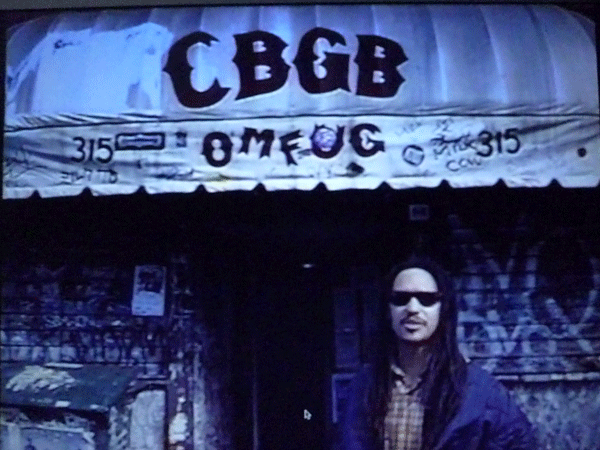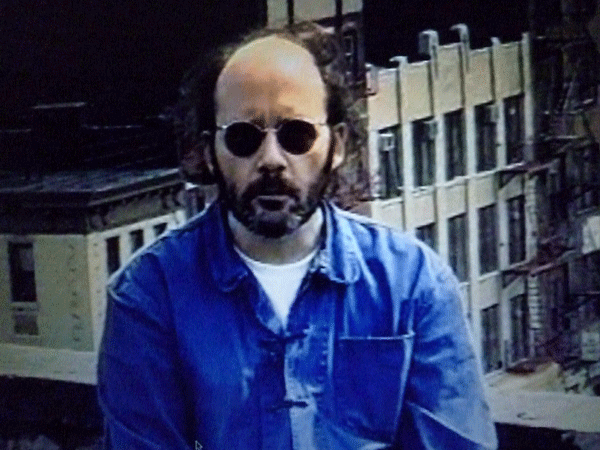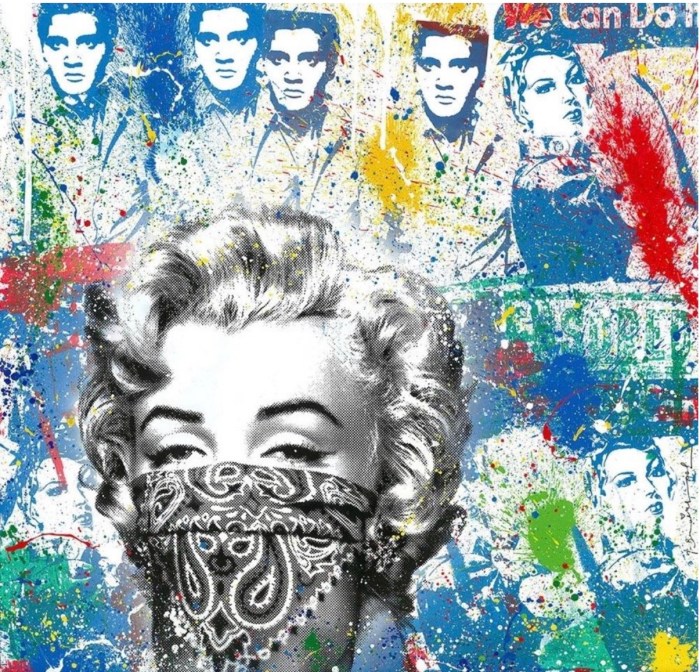 [/media-credit]
[/media-credit]
- Sara Driver, on a kinder, gentler Bowery.
New York Anthology retrospective reveals small but significant body of work
BY SCOTT STIFFLER | Have a conversation with filmmaker Sara Driver about New York cinema and city life in and around the 1980s and you’ll soon notice her habitual, perhaps subconscious, use of the word “magic.” Whether referencing the Bowery circa 1994 or NYU’s film school when punk was in full bloom or the nature of her next project, Driver invokes that word the way you and I use conjunctions — out of necessity, in order to string urgent thoughts into effectively structured sentences.
It’s appropriate, then, that Driver’s current retrospective at Anthology Film Archives owes its very existence to an unexpected event that unspooled with karmic elegance…maybe even a touch of magic (or, at the very least, serendipity).
Missing for years, and feared lost to the ages, Driver’s “You Are Not I” (her 1981 debut as a director) turned up in Tangiers in 2008 — in the form of a 16mm print found among the belongings of the late writer Paul Bowles. The 48-minute chronicle of a schizophrenic mental hospital escapee who wonders the rural New Jersey landscape was based on a short story by Bowles — who, in death, gave new life to Driver’s limited but distinguished body of work. “The discovery of ‘You Are Not I’ jump-started the preservation efforts,” says Driver.
 [/media-credit]
[/media-credit]
- Painter Billy Dock (from “The Bowery — Spring”).
Also screening at Anthology, in prime condition, will be the features “Sleepwalk” (1986) and “When Pigs Fly” (1993), along with “The Bowery — Spring” (a 1994 video short, it was part of a French national TV series called “Postcards From New York”).
In addition to these films, Driver produced 1980’s “Permanent Vacation” and 1984’s “Stranger Than Paradise.” Both films were directed by Jim Jarmusch (a kindred spirit of Driver’s minimalist style, he shot and co-wrote “You Are Not I”).
During the long “Paradise” production process, Driver used her own day job experiences and visions of city street life to form the basis of what would become her first feature-length film.
Featuring a cast including Ann Magnuson and Steve Buscemi, “Sleepwalk” concerns a copy shop worker who unleashes all manner of curses and self-fulfilling prophecies when she mutters aloud the text of the ancient scroll she’s been hired to translate. A mystery without resolution, and a dream from which her main character literally never awakes, “Sleepwalk” is more concerned with memorable images of almond-strewn floors, machinery acting on its own volition and near-deserted streets than it is with the chases and crises which could have easily sprung forth from the narrative.
From 1982 to 1984, when “Stranger Than Paradise” was put on hiatus due to lack of funds, Driver worked at Todd’s Copy Shop, on Mott Street (alongside Sonic Youth’s Kim Gordon). “It was a perfect job,” Driver recalls. “I remember the flashes from the Xerox machine would put me in a kind of trance. And I kept a journal of things I would see on the street. I used to see very odd interactions between people or overhear something, and I wrote all these things down.”
Perhaps, she admits, it’s nostalgia casting a forgiving patina over memories of the past…but Driver maintains that city life at the time was, “just one step out of reality, into a little bit of magic. New York really did have magic then, because it was such an empty city. It was very cheap to live here. You could have a job in a Xerox store and pay your rent and have your food. People didn’t want to be here…and the people who were, really wanted to be here.”
Shot in Chinatown and on the Bowery, Driver recalls the production process of “Sleepwalk” as one of camaraderie that stands in stark contrast to Gotham’s hellish reputation at the time. Living Downtown may have had its risks, but it wasn’t without civility (at least for the locals). Recalling a friend who lived on Avenue A “when it was rough and war-torn,” Driver notes, “Somebody mugged him on the way home, then saw that he lived on Avenue A. They ran back and gave him his money back.”
After the modestly catered meals were over during filming scenes for “Sleepwalk” on the Bowery, Driver recalls, “We would have food left over and we’d put a table outside for the guys. They’d line up very politely for the food. There was a kind of genteelness back then. I actually felt a lot safer [in the neighborhood] than I do now. Now, there’s an aggression on the street that I don’t remember feeling. Maybe it’s the financial difference between the rich and the poor…because at the time, we were all the same. Maybe it was a false feeling, but I really felt people were watching each other’s back. Recently, I gave some guy on the street some money, and he said ‘Why are you so kind?’ Maybe we’ve become less compassionate as human beings, because there’s so many of us.”
Driver’s current project — already written and awaiting adequate financing — hopes to ignite that spark of kindness and concern in the next generation. “I’ve noticed there’s been a lack of films for children and a lack of magic in our world for adults,” says Driver. “So I started thinking of metamorphosis folk tales, animal to human, human to animal. I wanted to do an anthology, ‘Tales from the Hanging Head.’ I found all these stories, and adapted them so the magic will feel very present.”
 [/media-credit]
[/media-credit]
Hopefully, that limitation will challenge her fellow Gangsters to conjure images that have a ring of reality, and truth, that can’t be created with ones and zeroes. “If you don’t have imagination,” Driver reasons, “you don’t progress.”
Sleepwalking: the films of sara driver
March 23 through April 1
At Anthology Film Archives
32 Second Ave., at 2nd St.
Tickets: $9 general, $7 for students, seniors and children (12 & under); $6 for AFA members
For screening dates and times: anthologyfilmarchives.org
Driver and actress Suzanne Fletcher will be present at select screenings. Also part of the retrospective: “Sara Driver Selects” — a series of works that influenced her, or are favorites (including “Cat People” and “Topper”)
Anthology’s retrospective coincides with a DVD box set release of Driver’s digitally restored films (available on DVD/ VOD through Films We Like and New Video)

















